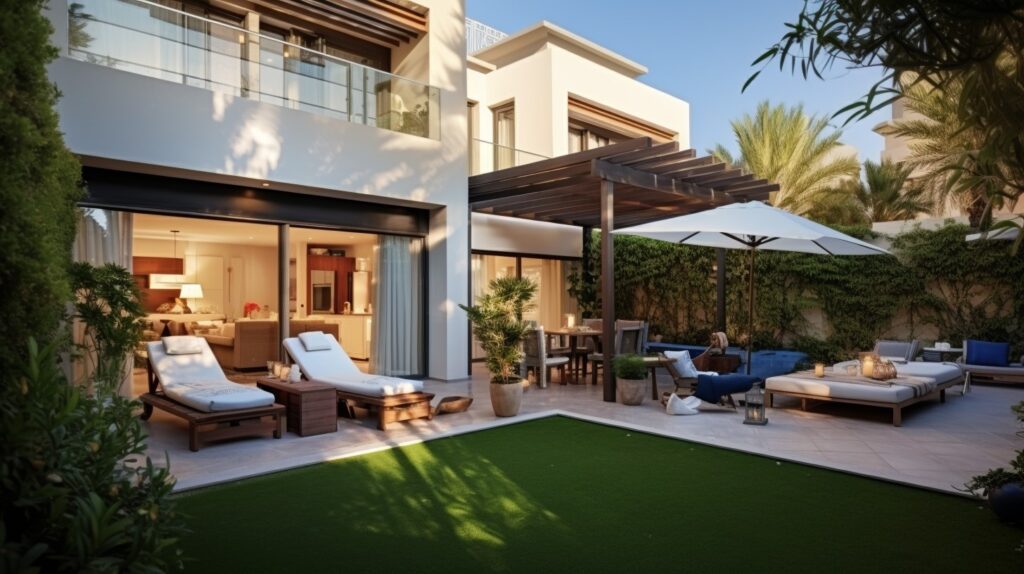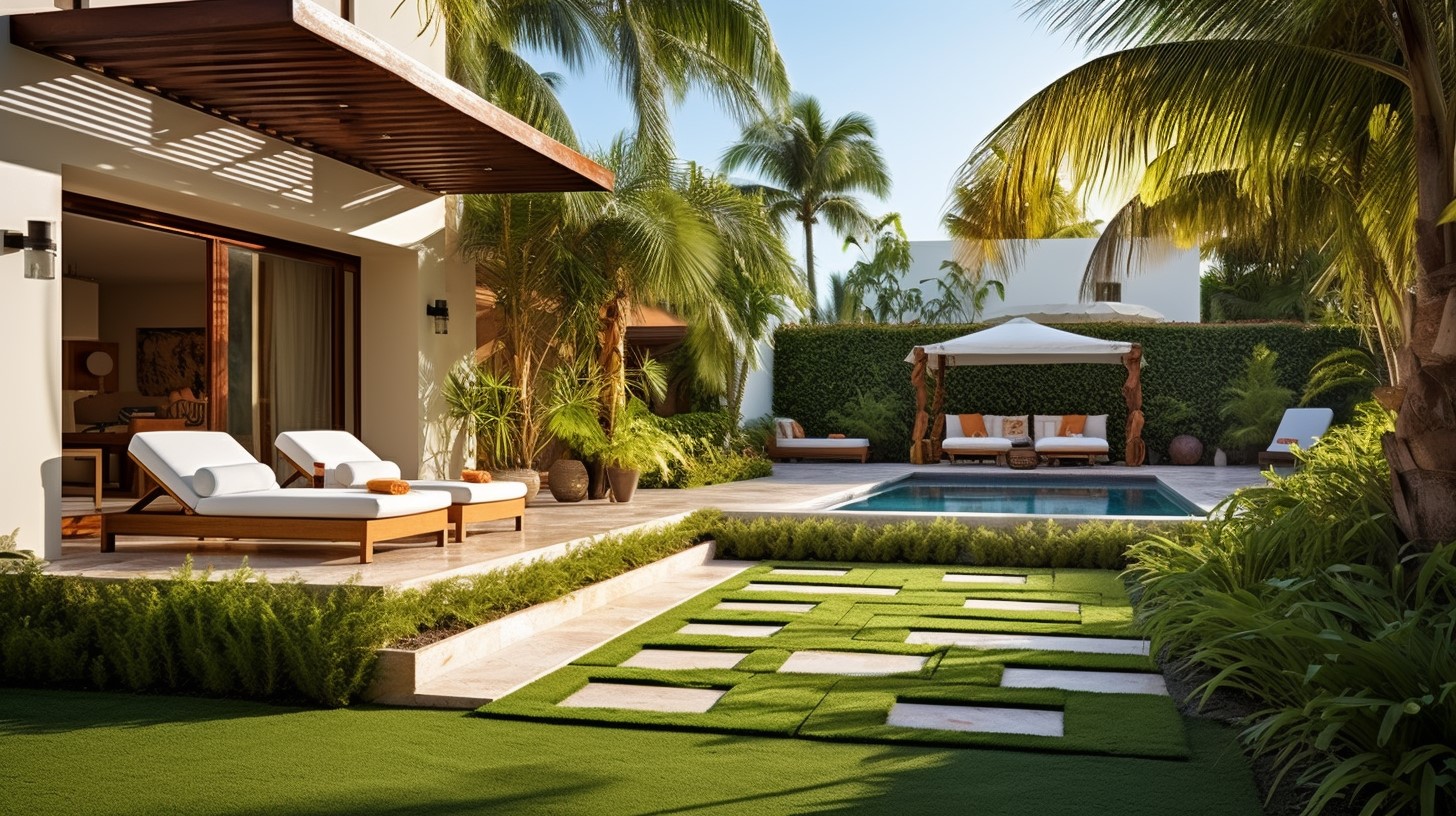Introduction
In the heart of Dubai, a city known for its awe-inspiring skyscrapers and luxurious lifestyle, lies an unexpected and often overlooked treasure – the villa gardens. As a seasoned real estate professional living in Dubai for over a decade, I have explored these hidden gems that offer a serene escape from the bustling city life. These gardens are not just greenery spaces; they are meticulously designed landscapes that blend the beauty of nature with the luxury of urban living. In this article, I will take you through the enchanting villa gardens of Dubai, revealing their unique features, the variety of flora they host, and the tranquility they offer residents and visitors alike.
The Essence of Villa Gardens in Dubai
The concept of villa gardens in Dubai transcends the traditional idea of a garden. Each garden is a microcosm of the world’s diverse flora and fauna. In communities like Emirates Hills and The Meadows, villa gardens are more than just lawns and trees; they are thoughtfully curated to complement the architectural elegance of the villas. These gardens often blend indigenous plants like the Ghaf tree, known for its resilience in the desert climate, and exotic species like the fragrant Frangipani and vibrant Bougainvillea, adding color and life to the landscape.
The meticulous planning of these gardens is evident in their layout – from the symmetry of the pathways to the strategic placement of water features and sitting areas. For instance, a villa in Emirates Hills boasts a garden with a miniature lake, home to koi fish and surrounded by lush ferns and palms, creating a tranquil oasis for the residents. The cost of maintaining such a garden can range from AED 2,000 to AED 10,000 per month, depending on its size and the complexity of the landscape.
These villa gardens are not just for show; they serve as personal retreats for the residents. I have seen families enjoying their morning coffee amidst birds chirping and children playing on the manicured lawns, making these gardens an integral part of their lifestyle. They also serve as perfect backdrops for social gatherings, with some villas even featuring outdoor barbeque areas and fire pits, blending entertainment with the beauty of nature.
Showcase of Prominent Villa Gardens
Dubai’s villa gardens are as varied as beautiful, each with a unique character. Let’s delve into two such prominent gardens:
- Garden A in Emirates Hills: This garden is a perfect example of a desert oasis. It seamlessly integrates local desert flora with modern landscaping techniques. The centerpiece is a majestic date palm, surrounded by a bed of vibrant desert flowers and drought-tolerant shrubs like Lantana and Bougainvillea. The garden’s design emphasizes sustainability, using drip irrigation systems to minimize water usage, a crucial aspect of Dubai’s arid climate. The pathways are laid out with natural stone, and hidden among the greenery are quaint seating areas offering a peaceful retreat.
- Garden B in The Palm Jumeirah: Contrasting with the desert theme, this garden is an homage to tropical landscapes. It features a lush lawn bordered by various palm trees, creating a canopy of greenery. The highlight is a small, artificial waterfall, adding the soothing sound of flowing water. Exotic plants like Bird of Paradise and Hibiscus add splashes of color, and the garden is equipped with ambient lighting, transforming it into a magical space in the evenings. Maintaining such a garden is a meticulous task, often involving a team of gardeners, and can cost upwards of AED 15,000 per month.
These gardens demonstrate the versatility and creativity in Dubai’s villa garden designs, offering residents homes and a lifestyle close to nature. As a real estate expert, I have noticed that properties with well-maintained gardens tend to have higher market values, reflecting the desirability of these green havens in the city.
Notable Green Spaces Near Villa Communities
As a long-time resident and real estate specialist in Dubai, I’ve seen how the city’s commitment to greenery extends beyond private gardens to larger communal spaces. Two of the most remarkable green spaces that significantly enhance the living experience in nearby villa communities are the Dubai Miracle Garden and the Dubai Butterfly Garden. These attractions are not just tourist destinations; they are integral to the lifestyle and environment of the adjacent residential areas.
Dubai Miracle Garden: Located in the Dubailand area, near many villa communities, the Dubai Miracle Garden is a world-renowned attraction, holding the record for the world’s most extensive natural flower garden. Spanning over 72,000 square meters and hosting over 50 million flowers, this garden is a spectacle of color and creativity.
The flowers are arranged in intricate designs, ranging from archways to figures and patterns, which change every season. The garden’s proximity to residential areas like Arabian Ranches and Motor City provides villa residents with an easy escape to one of the city’s most beautiful and serene environments. The garden is open from November to March, aligning with Dubai’s cooler months, and the entry fee is around AED 55 per person. Such a magnificent garden near villa communities offers a recreational spot and positively impacts the local microclimate, making these areas more relaxed and pleasant.
Dubai Butterfly Garden: Situated right next to the Miracle Garden is the Dubai Butterfly Garden, another testament to Dubai’s love for nature. This garden is home to over 15,000 butterflies from around 50 different species. Enclosed in ten custom-built domes, this is the world’s largest and the region’s first indoor butterfly garden. The experience of walking among thousands of freely flying butterflies is truly magical and offers residents of nearby villas a unique leisure activity. The garden is meticulously maintained to simulate the natural habitat of the butterflies, with lush plants and controlled temperature and humidity. It’s not just a tourist attraction; it’s an educational experience where visitors can learn about the life cycle and various species of butterflies. The garden is open year-round, with an entry fee of approximately AED 50. Its proximity to villa communities adds a unique charm and value to these residential areas, offering a perfect weekend activity for families.
Sustainable Practices in Garden Maintenance
In Dubai’s villa gardens, sustainability is not just a concept; it’s a practice. As an expert in Dubai’s real estate, I have seen a growing trend in sustainable gardening practices among villa owners. These practices are crucial in a city like Dubai, where the harsh climate and limited water resources pose significant challenges.
One of the critical sustainable practices adopted in villa gardens is water conservation. Many villas now use drip irrigation systems, which deliver water directly to the plant roots, drastically reducing water wastage. Some advanced systems even have sensors to adjust watering based on soil moisture levels and weather conditions. For instance, a villa in The Lakes community uses an intelligent irrigation system that has reduced its water usage for gardening by almost 40%. This not only helps conserve precious water resources but also significantly reduces the utility bills for homeowners.
Another sustainable practice is the use of organic fertilizers and pesticides. More villa owners are moving away from chemical products and adopting organic alternatives that do not harm the environment. This shift is crucial for maintaining healthy soil and preventing groundwater contamination. Moreover, many villa gardens are now designed to attract beneficial insects like bees and butterflies, promoting biodiversity and ecological balance.
Solar-powered garden lighting is also gaining popularity. Instead of traditional electric lights, many villas now have solar lights that store energy during the day and illuminate the gardens at night. This reduces electricity consumption and adds a charming ambiance to the parks in the evenings.

These sustainable practices in garden maintenance are not just environmentally friendly but also economically beneficial in the long run. They reflect a growing awareness among residents of their environmental impact and a commitment to making Dubai a greener and more sustainable city. As a real estate expert, I have noticed that villas implementing these sustainable practices often have a higher value in the market as they cater to the growing demand for eco-friendly living spaces.
Gardens as a Reflection of Lifestyle and Culture
In my extensive experience in Dubai’s real estate market, I have observed that villa gardens are not merely ornamental; they reflect the residents’ lifestyle and the rich cultural heritage of the UAE. These gardens serve as a symbol of status, a haven for relaxation, and a space for social and family activities, deeply ingrained in the social fabric of Dubai.
The garden in a Dubai villa is often seen as an extension of the home itself. It is a place where families gather for meals, children play, and friends are entertained. For many residents, the garden is a private retreat from the fast-paced urban life, offering a sense of peace and connection with nature. In communities like Jumeirah Islands and Al Barari, villa gardens are meticulously designed to provide such an experience. They often feature traditional Arabic elements such as Majlis-style seating areas, reflecting the culture of hospitality and social interaction in the region.
Moreover, these gardens are a testament to the residents’ lifestyle choices. For those who value health and wellness, gardens often include organic vegetable patches and herb gardens, providing fresh produce for healthy cooking. In some luxury villas, gardens are designed to accommodate yoga and meditation spaces, reinforcing the importance of mental and physical well-being in today’s high-stress world.
Culturally, gardens in Dubai carry a significance that goes beyond aesthetics. They are a homage to the region’s historical relationship with nature, especially in a desert landscape where greenery is a luxury. The traditional Islamic garden, for example, is an architectural style deeply rooted in history, characterized by symmetry, water features, and the use of fragrant plants. This style is still evident in some of the villa gardens, blending historical elements with modern design and creating culturally significant and contemporarily relevant spaces.
Conclusion
Concluding, the villa gardens of Dubai are more than just landscaped areas; they are the heart and soul of the villas, adding to the charm and luxury of the properties. As an expert in Dubai’s real estate with many years of experience, I have seen how these gardens enhance the villas’ overall appeal, making them residences and true havens of serenity and beauty.
These gardens reflect the evolving lifestyle of Dubai’s residents, who seek a balance between the bustling city life and the tranquility of nature. They are a crucial element in the architectural design of villas, adding value both aesthetically and functionally. From hosting social gatherings to providing a quiet space for relaxation, these gardens play a vital role in the residents’ daily lives.
Looking to the future, it is evident that the importance of villa gardens in Dubai will only continue to grow. As the city advances, there is a growing emphasis on sustainability and green living, and villa gardens are at the forefront of this movement. They contribute to the city’s aesthetic beauty and play a significant role in environmental conservation. The trend of sustainable gardening practices, such as water conservation and organic materials, is likely to continue, making these gardens visually pleasing and ecologically responsible.
In conclusion, the villa gardens of Dubai are a unique blend of luxury, culture, and sustainability. They are an integral part of the city’s real estate landscape, reflecting the lifestyle and values of its residents. As Dubai continues to evolve, these gardens will remain a vital and cherished aspect of its urban environment.
